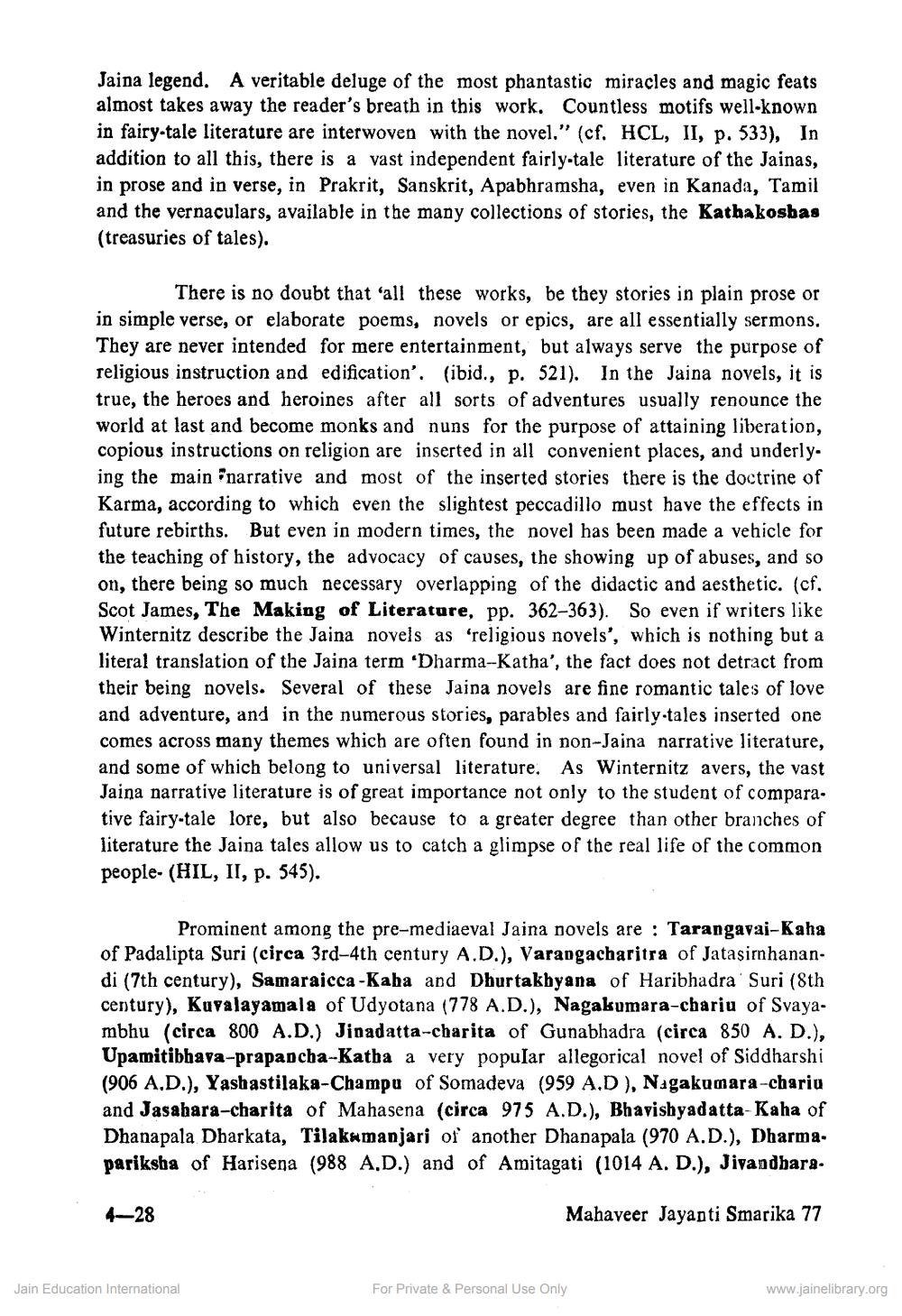________________
Jaina legend. A veritable deluge of the most phantastic miracles and magic feats almost takes away the reader's breath in this work. Countless motifs well-known in fairy-tale literature are interwoven with the novel." (cf. HCL, II, p. 533), In addition to all this, there is a vast independent fairly-tale literature of the Jainas, in prose and in verse, in Prakrit, Sanskrit, Apabhramsha, even in Kanada, Tamil and the vernaculars, available in the many collections of stories, the Kathakosbas (treasuries of tales).
There is no doubt that all these works, be they stories in plain prose or in simple verse, or elaborate poems, novels or epics, are all essentially sermons. They are never intended for mere entertainment, but always serve the purpose of religious instruction and edification'. (ibid., p. 521). In the Jaina novels, it is true, the heroes and heroines after all sorts of adventures usually renounce the world at last and become monks and nuns for the purpose of attaining liberation, copious instructions on religion are inserted in all convenient places, and underly. ing the main "narrative and most of the inserted stories there is the doctrine of Karma, according to which even the slightest peccadillo must have the effects in future rebirths. But even in modern times, the novel has been made a vehicle for the teaching of history, the advocacy of causes, the showing up of abuses, and so on, there being so much necessary overlapping of the didactic and aesthetic. (cf. Scot James, The Making of Literature, pp. 362-363). So even if writers like Winternitz describe the Jaina novels as 'religious novels', which is nothing but a literal translation of the Jaina term 'Dharma-Katha', the fact does not detract from their being novels. Several of these Jaina novels are fine romantic tales of love and adventure, and in the numerous stories, parables and fairly-tales inserted one comes across many themes which are often found in non-Jaina narrative literature, and some of which belong to universal literature. As Winternitz avers, the vast Jaina narrative literature is of great importance not only to the student of comparative fairy-tale lore, but also because to a greater degree than other branches of literature the Jaina tales allow us to catch a glimpse of the real life of the common people- (HIL, II, p. 545).
Prominent among the pre-mediaeval Jaina novels are : Tarangavai-Kaha of Padalipta Suri (circa 3rd-4th century A.D.), Varangacharitra of Jatasirnhanandi (7th century), Samaraicca -Kaha and Dhurtakhyana of Haribhadra Suri (8th century), Kuvalayamala of Udyotana (778 A.D.), Nagakumara-charju of Svayambhu (circa 800 A.D.) Jinadatta-charita of Gunabhadra (circa 850 A.D.), Upamitibhava-prapancha-Katba a very popular allegorical novel of Siddharshi (906 A.D.), Yashastilaka-Champu of Somadeva (959 A.D), Nagakumara-chariu and Jasahara-charita of Mahasena (circa 975 A.D.), Bhavishyadatta-Kaha of Dhanapala Dharkata, Tilakumanjari of another Dhanapala (970 A.D.), Dharmapariksha of Harisena (988 A.D.) and of Amitagati (1014 A. D.), Jivandhara.
4—28
Mahaveer Jayanti Smarika 77
Jain Education International
For Private & Personal Use Only
www.jainelibrary.org




